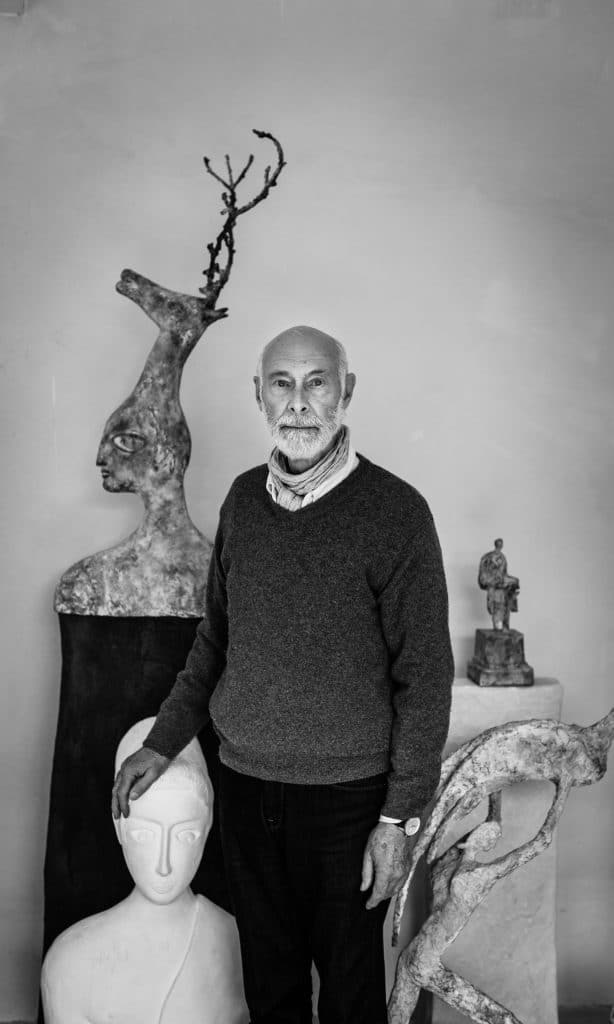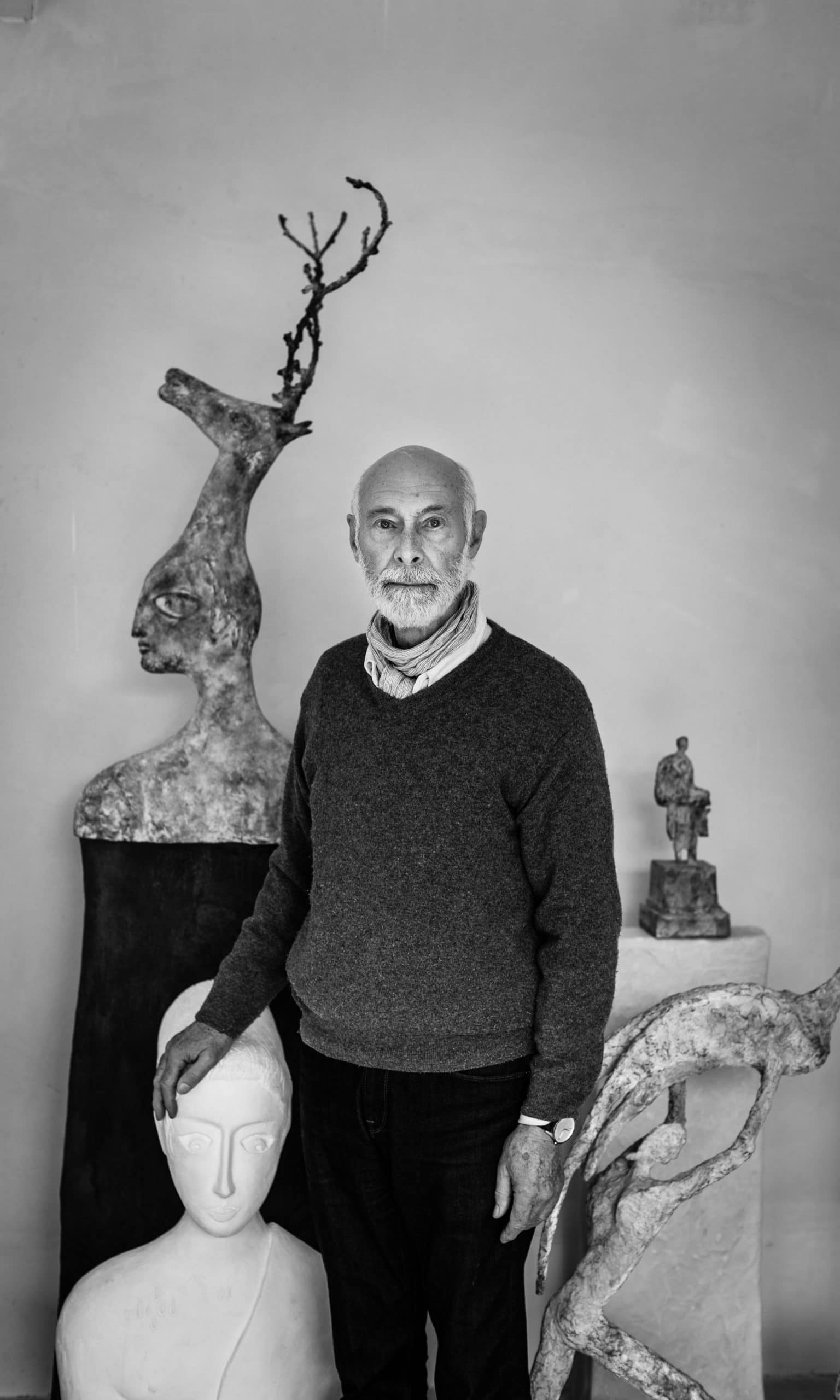
JEAN BILQUIN
Jean Bilquin was educated as a graphic artist and studied at the Royal Academy of Fine Arts in Ghent. Nowadays he works and lives in Drongen (Ghent). From 1979 to 2002 he taught painting at the Ghent Academy.
In 1999 the Provincial Museum of Modern Art in Ostend organised a huge retrospective of his work. The monograph published at that occasion is a treasury of information about the artist, with texts written by the headcurator Willy Van den Bussche, by the professors Willem Elias (Free University of Brussels) and Freddy Decreus (University of Ghent) and by Katrien Noblesse. An important solo-exhibition took place in the restored Caermers-cloister in Ghent in 2003, with in the catalogue academic studies by the professors Karel Boullart (University of Ghent) and Freddy Decreus and an art-historical point of view by Marc Ruyters. In 2006 his contribution to Beaufort in Zeebrugge was the marvellous and highly acclaimed sculpture: “The man who saw the boat, in the sky”.
In 2008 a new retrospective in Kunsthal Sint-Pietersabdij in Ghent completed this serie of remarkable exhibitions. The publication contains essays written by Willy Van den Bussche and by the professors Willem Elias and Peter De Graeve (University of Antwerp). Eight themes formed the basis for the divisions of the exhibition: The boat, Man and beast, Sisyphus or the burden, Orpheus, The approach, Paradise and heaven, Mother and child, The step.
Jean Bilquin is indeed an artist who works with an open mind. He does not want to create a distance with his art. His work arouses a feeling of total harmony, for which nature and the cosmos are the starting point and the norm. As a visual artist Jean Bilquin is not about “l’art pour l’art”. He lovingly works with acrylic paint, pigment and medium on canvas, with ink, pencil, charcoal and pastel on paper, and conceives his images in plaster before transforming them into bronze. He paints, draws and sculpts his own emotions. He turns energy into matter.
Recently his figures are reduced to slender silhouettes in an almost empty and undefined spiritual space. The artist tries to add a metaphysical sensation to the work. Moreover, it is striking to see how in recent years the two-dimensional aspect of the canvas or paper is completed with a series of wonderful statues or installations in plaster, concrete or bronze. Jean Bilquin always situates his figures between extremes: heaven and earth, life and death, the inner world and the outside world. He created an exciting body of work situated in the twilight zone between tradition and renewal.
In 1999 the Provincial Museum of Modern Art in Ostend organised a huge retrospective of his work. The monograph published at that occasion is a treasury of information about the artist, with texts written by the headcurator Willy Van den Bussche, by the professors Willem Elias (Free University of Brussels) and Freddy Decreus (University of Ghent) and by Katrien Noblesse. An important solo-exhibition took place in the restored Caermers-cloister in Ghent in 2003, with in the catalogue academic studies by the professors Karel Boullart (University of Ghent) and Freddy Decreus and an art-historical point of view by Marc Ruyters. In 2006 his contribution to Beaufort in Zeebrugge was the marvellous and highly acclaimed sculpture: “The man who saw the boat, in the sky”.
In 2008 a new retrospective in Kunsthal Sint-Pietersabdij in Ghent completed this serie of remarkable exhibitions. The publication contains essays written by Willy Van den Bussche and by the professors Willem Elias and Peter De Graeve (University of Antwerp). Eight themes formed the basis for the divisions of the exhibition: The boat, Man and beast, Sisyphus or the burden, Orpheus, The approach, Paradise and heaven, Mother and child, The step.
Jean Bilquin is indeed an artist who works with an open mind. He does not want to create a distance with his art. His work arouses a feeling of total harmony, for which nature and the cosmos are the starting point and the norm. As a visual artist Jean Bilquin is not about “l’art pour l’art”. He lovingly works with acrylic paint, pigment and medium on canvas, with ink, pencil, charcoal and pastel on paper, and conceives his images in plaster before transforming them into bronze. He paints, draws and sculpts his own emotions. He turns energy into matter.
Recently his figures are reduced to slender silhouettes in an almost empty and undefined spiritual space. The artist tries to add a metaphysical sensation to the work. Moreover, it is striking to see how in recent years the two-dimensional aspect of the canvas or paper is completed with a series of wonderful statues or installations in plaster, concrete or bronze. Jean Bilquin always situates his figures between extremes: heaven and earth, life and death, the inner world and the outside world. He created an exciting body of work situated in the twilight zone between tradition and renewal.
Ernest Van Buynder
M HKA Past-president
Museum of Contemporary Art Antwerp
September 2009
JEAN BILQUIN
Jean Bilquin was educated as a graphic artist and studied at the Royal Academy of Fine Arts in Ghent. Nowadays he works and lives in Drongen (Ghent). From 1979 to 2002 he taught painting at the Ghent Academy.
In 1999 the Provincial Museum of Modern Art in Ostend organised a huge retrospective of his work. The monograph published at that occasion is a treasury of information about the artist, with texts written by the headcurator Willy Van den Bussche, by the professors Willem Elias (Free University of Brussels) and Freddy Decreus (University of Ghent) and by Katrien Noblesse. An important solo-exhibition took place in the restored Caermers-cloister in Ghent in 2003, with in the catalogue academic studies by the professors Karel Boullart (University of Ghent) and Freddy Decreus and an art-historical point of view by Marc Ruyters. In 2006 his contribution to Beaufort in Zeebrugge was the marvellous and highly acclaimed sculpture: “The man who saw the boat, in the sky”.
In 2008 a new retrospective in Kunsthal Sint-Pietersabdij in Ghent completed this serie of remarkable exhibitions. The publication contains essays written by Willy Van den Bussche and by the professors Willem Elias and Peter De Graeve (University of Antwerp). Eight themes formed the basis for the divisions of the exhibition: The boat, Man and beast, Sisyphus or the burden, Orpheus, The approach, Paradise and heaven, Mother and child, The step.
Jean Bilquin is indeed an artist who works with an open mind. He does not want to create a distance with his art. His work arouses a feeling of total harmony, for which nature and the cosmos are the starting point and the norm. As a visual artist Jean Bilquin is not about “l’art pour l’art”. He lovingly works with acrylic paint, pigment and medium on canvas, with ink, pencil, charcoal and pastel on paper, and conceives his images in plaster before transforming them into bronze. He paints, draws and sculpts his own emotions. He turns energy into matter.
Recently his figures are reduced to slender silhouettes in an almost empty and undefined spiritual space. The artist tries to add a metaphysical sensation to the work. Moreover, it is striking to see how in recent years the two-dimensional aspect of the canvas or paper is completed with a series of wonderful statues or installations in plaster, concrete or bronze. Jean Bilquin always situates his figures between extremes: heaven and earth, life and death, the inner world and the outside world. He created an exciting body of work situated in the twilight zone between tradition and renewal.
In 1999 the Provincial Museum of Modern Art in Ostend organised a huge retrospective of his work. The monograph published at that occasion is a treasury of information about the artist, with texts written by the headcurator Willy Van den Bussche, by the professors Willem Elias (Free University of Brussels) and Freddy Decreus (University of Ghent) and by Katrien Noblesse. An important solo-exhibition took place in the restored Caermers-cloister in Ghent in 2003, with in the catalogue academic studies by the professors Karel Boullart (University of Ghent) and Freddy Decreus and an art-historical point of view by Marc Ruyters. In 2006 his contribution to Beaufort in Zeebrugge was the marvellous and highly acclaimed sculpture: “The man who saw the boat, in the sky”.
In 2008 a new retrospective in Kunsthal Sint-Pietersabdij in Ghent completed this serie of remarkable exhibitions. The publication contains essays written by Willy Van den Bussche and by the professors Willem Elias and Peter De Graeve (University of Antwerp). Eight themes formed the basis for the divisions of the exhibition: The boat, Man and beast, Sisyphus or the burden, Orpheus, The approach, Paradise and heaven, Mother and child, The step.
Jean Bilquin is indeed an artist who works with an open mind. He does not want to create a distance with his art. His work arouses a feeling of total harmony, for which nature and the cosmos are the starting point and the norm. As a visual artist Jean Bilquin is not about “l’art pour l’art”. He lovingly works with acrylic paint, pigment and medium on canvas, with ink, pencil, charcoal and pastel on paper, and conceives his images in plaster before transforming them into bronze. He paints, draws and sculpts his own emotions. He turns energy into matter.
Recently his figures are reduced to slender silhouettes in an almost empty and undefined spiritual space. The artist tries to add a metaphysical sensation to the work. Moreover, it is striking to see how in recent years the two-dimensional aspect of the canvas or paper is completed with a series of wonderful statues or installations in plaster, concrete or bronze. Jean Bilquin always situates his figures between extremes: heaven and earth, life and death, the inner world and the outside world. He created an exciting body of work situated in the twilight zone between tradition and renewal.
Ernest Van Buynder
M HKA Past-president
Museum of Contemporary Art Antwerp
September 2009

